
Intel didn't have a lot of new information to hand out to the press seated at its CES event on Monday afternoon—most of what it had to show off were things we heard about before, whether through official or unofficial channels. What the conference did was give us a comprehensive look at the company's products and initiatives for 2013.
If you're familiar with Intel's initiatives of late, its new products are staying that course: emphasizing power consumption over all else and continuing to push its Atom processors into tablets and smartphones. Ultrabooks and convertible laptops also continue to factor prominently into the company's future plans, both with the next-generation Haswell chips and new Ivy Bridge processors that use even less power than the ones in currently shipping Ultrabooks.
Atom in smartphones
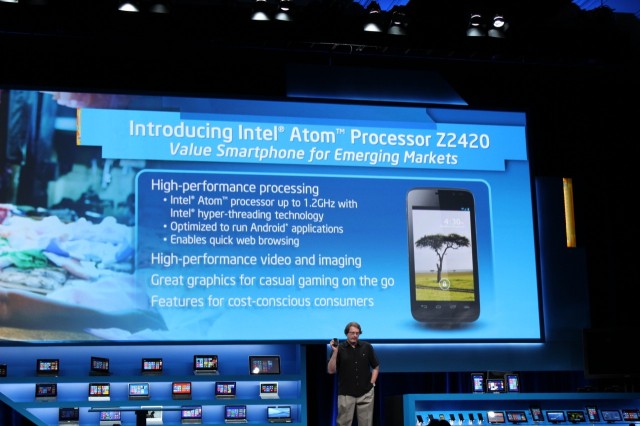
According to Intel, there are seven smartphones in the global market using its current Atom platform, codenamed Medfield. None of these phones, which are based on Intel's Atom Z2460 have really been aimed at the US market. But they've been relatively well-reviewed, and most importantly they appear to be competitive with ARM smartphones in both performance and battery life. An Intel-optimized version of Android and a compatibility layer for ARM-native apps in the Google Play store help to keep these phones familiar for users even though they're completely different from most Android handsets under the hood.
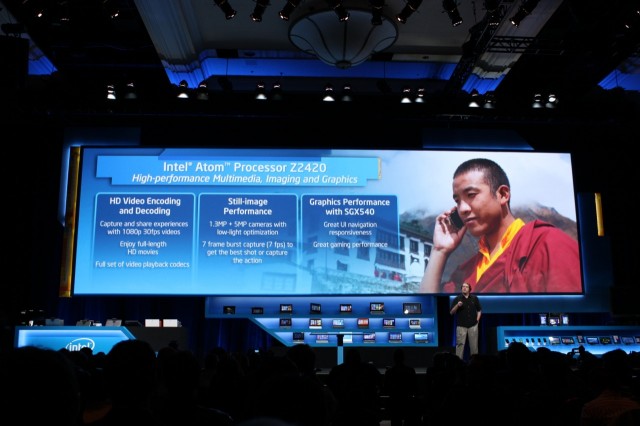
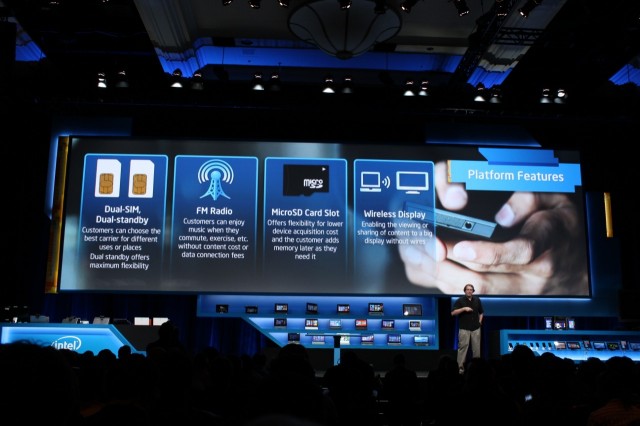
Intel spent the most time today on a processor not intended to replace the Z2460, but to augment it: the Atom Z2420 (codenamed Lexington) is a 1.2GHz smartphone SoC based on the same Saltwell architecture as its bigger brother, but it's aimed at "emerging markets." It's definitely no powerhouse—its Imagination Technology SGX540 GPU was first released in 2007—but it features 30FPS 1080p video playback and quick photo capture, (two features important for its target audience), as well as HSPA+ connectivity provided by a modem of Intel's design.
Intel's next-generation Atom for smartphones, based on the company's 22nm manufacturing process, existed only as a nebulous "next generation" product on one of its slides; we know it will be based on the next-generation Silvermont CPU architecture, but not much else.
Atom in tablets
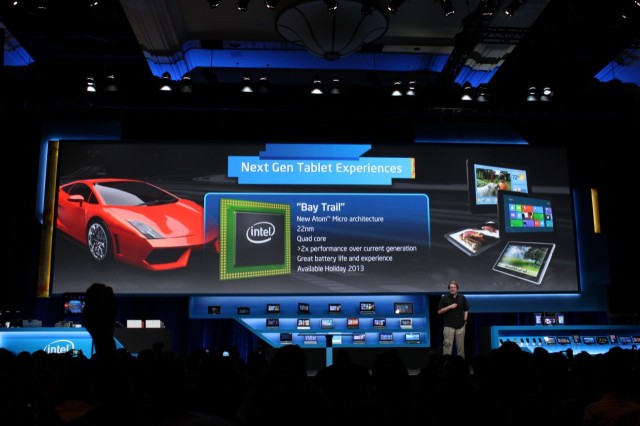
Intel's current-generation Clover Trail Atom platform is shipping in about ten Windows 8 tablets, according to the company, and like its smartphone chips, the Atom chips have proven to be mostly competitive with ARM chips in terms of performance and power consumption. In a tablet, there's an additional benefit—Intel-based tablets can run full Windows 8 and all of the desktop and legacy apps that entails; the ARM-only Windows RT can run only apps from the Windows Store and the built-in first-party desktop apps.
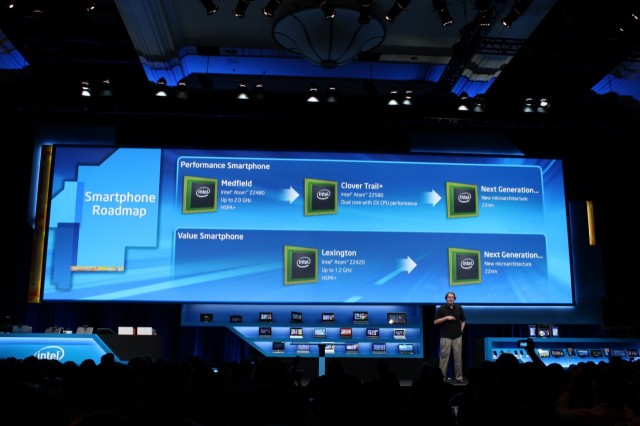
Clover Trail's follow-up is called Bay Trail, and it's a 22nm quad-core chip that promises twice the CPU performance of Clover Trail. Intel had three working Bay Trail-based tablets on the stage—they support Windows 8, of course, but unlike Clover Trail they will also support Android, using the same compatibility technology that makes Intel Android phones run.
Bay Trail-based systems should be available by "holiday 2013."
Ivy Bridge hits 7 watts
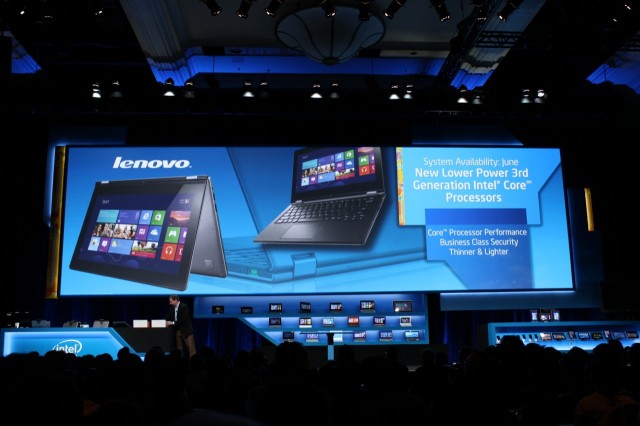
Intel has previously talked about new, low-power Ivy Bridge processors that would consume 10 watts of power instead of the 17 watts common in today's tablets and Ultrabooks. Today Intel announced that not only would these chips begin shipping to its partners today, but they would also use less power than anticipated: these Ivy Bridge chips have a TDP of just 7 watts.
PCs from both Lenovo and Acer using these 7 watt chips should be coming to market this spring and summer—Lenovo's system, the IdeaPad Yoga 11S, is actually a smaller version of the IdeaPad Yoga 13 we reviewed. The Yoga is one of the better Windows 8 convertibles we've seen so far, and an 11-inch form factor might make it a bit more plausible as a tablet than its big brother.
The Intel processor will make the 11S much more useful than the Windows RT-based IdeaPad Yoga 11 that Lenovo is currently shipping, and at $799 its starting price is only $70 more than the ARM-based system.
All's well that Haswell
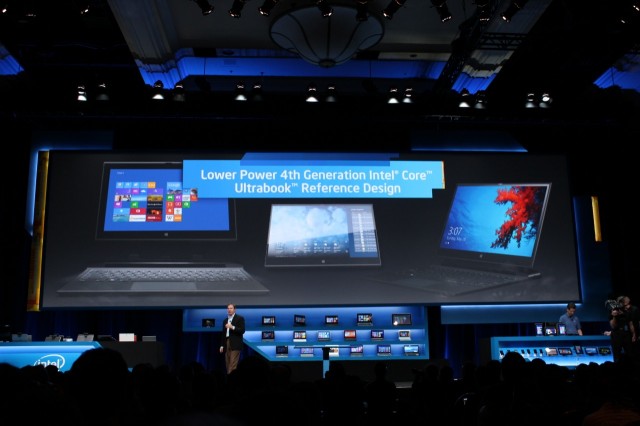
Actual technical details about Haswell, as well as information about availability, were thin on the ground, but mentions of the architecture were threaded throughout the presentation. Among other things, Intel hailed the architecture as the "largest generation-to-generation battery life increase in the history of Intel" and the first CPU architecture designed "from the ground up" for Ultrabooks and tablets, rather than being retrofitted for those form factors after the fact.
The company's first Haswell-based reference laptop, codenamed North Cape, is a convertible laptop with a detachable screen that tries to overcome the traditional shortcomings of convertible laptops (thickness and weight, mostly). The computer is just 17mm thick, but it still manages to include batteries in both the base and the screen (as is the case with other detachable convertibles).
Haswell will also bring some changes to the official (but not exactly stringent) requirements that OEM PCs must meet to earn the Ultrabook label. Most notably, Haswell Ultrabooks will be required to have touchscreens and will also be required to support Intel's Wireless Display technology—these are both features common to the Windows 8 Ultrabooks we've been seeing for the last year or so, but this year Intel wants to make them official requirements. Intel also wants to drive touchscreens down into the $599 price point, down from the $800-and-above spot that many of these machines occupy presently.
A potentially transformative year
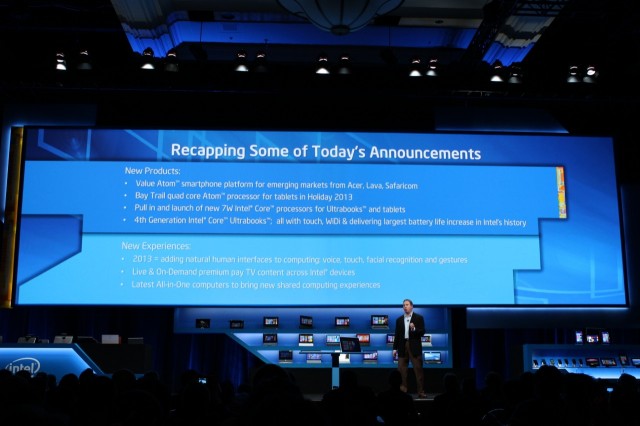
If Intel is to be believed, 2013 will be the year when the company's mobile strategy is finally realized: it will be easy to find and to buy x86-based laptops, tablets, and smartphones, and said devices will be competitive with ARM-based devices in speed, battery life, and price.
It remains to be seen whether these innovations will actually be able to drive out ARM-based SoCs from tablets and smartphones, where Intel's competitors are pretty entrenched—big companies like Apple and Samsung seem content to use their own chips in their devices rather than relying on an outside source. The biggest selling point for Windows tablets is full x86 compatibility, but no such advantage exists on Android tablets and phones.
What Intel's proponents believe is that Intel's manufacturing advantages will ultimately make its chips' performance-per-watt so far superior to the competition that they'll essentially be forced to use Intel chips or lose their competitive edge. 2013 probably won't be the year that Intel's chips can reach that level, but the company's execution is definitely strong enough to make it plausible.
reader comments
70